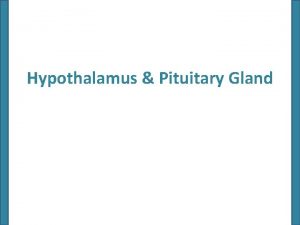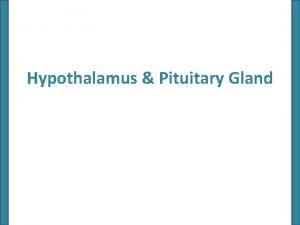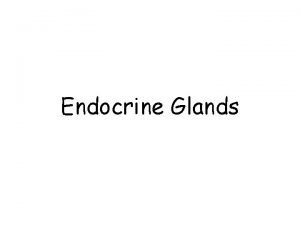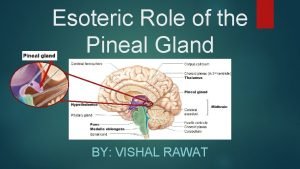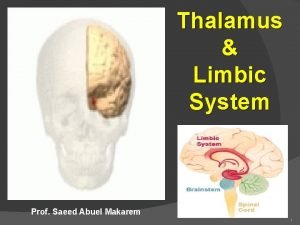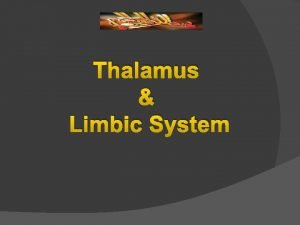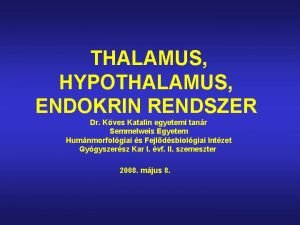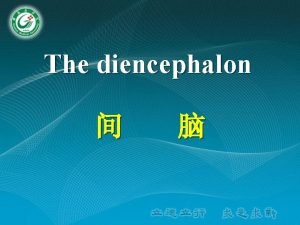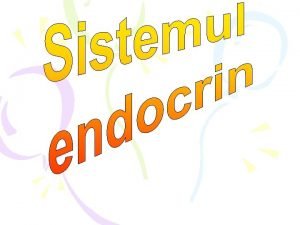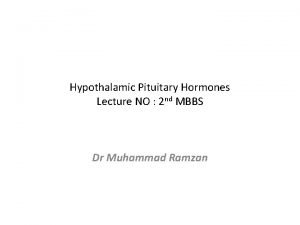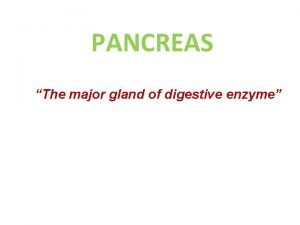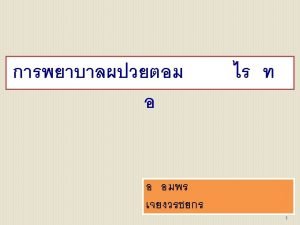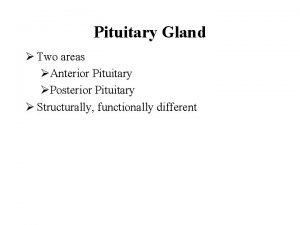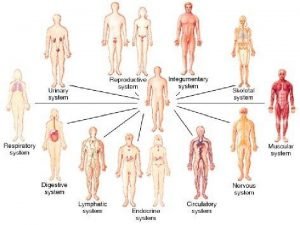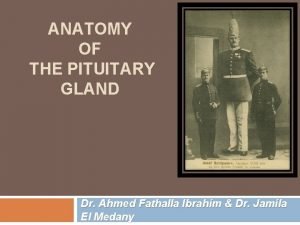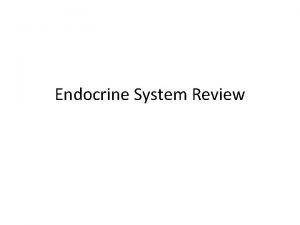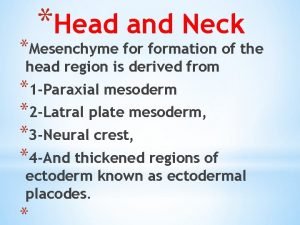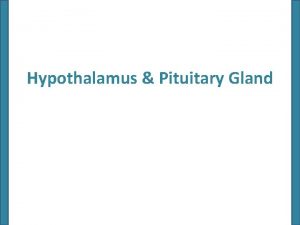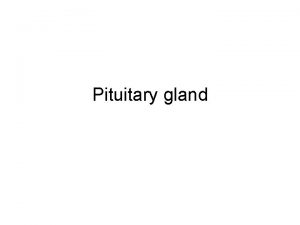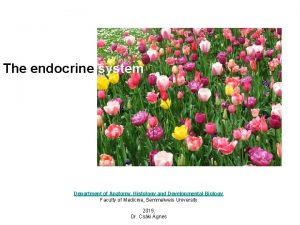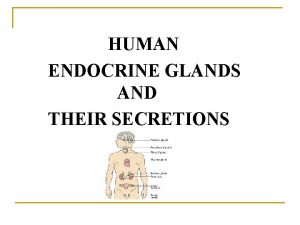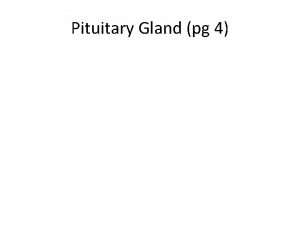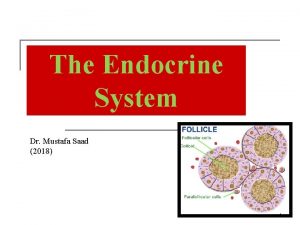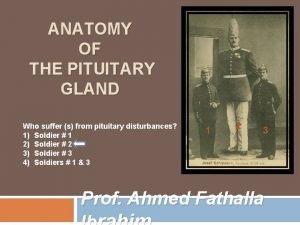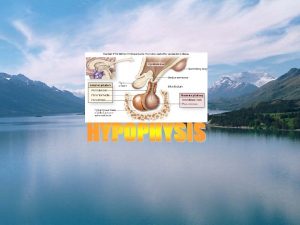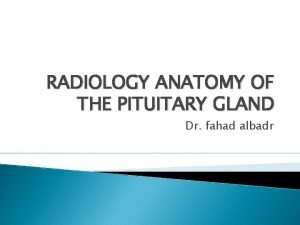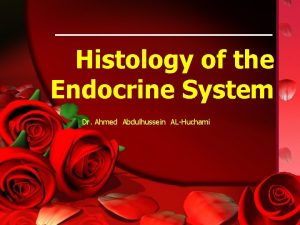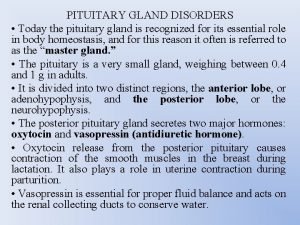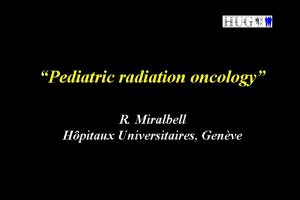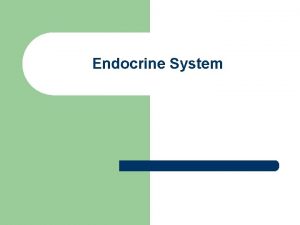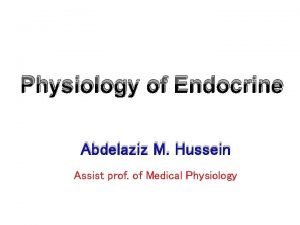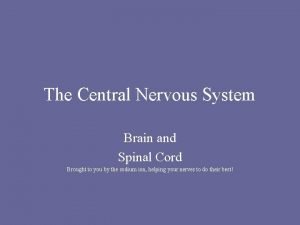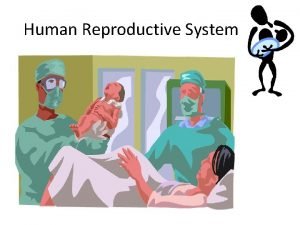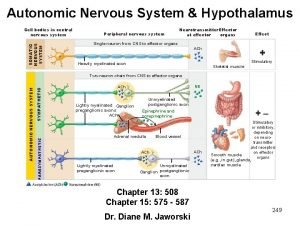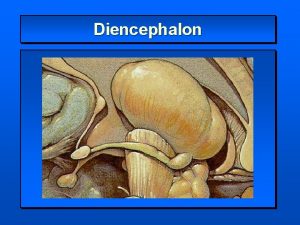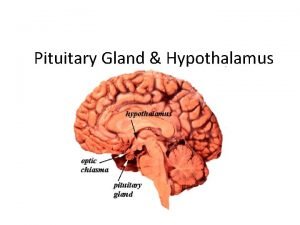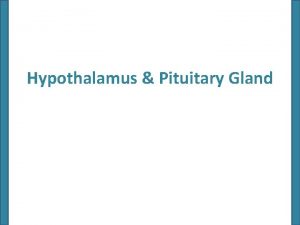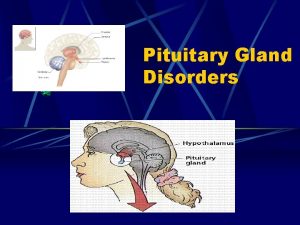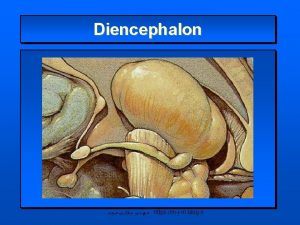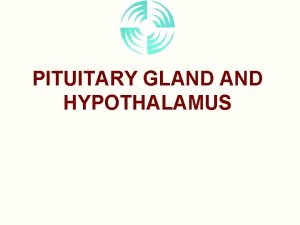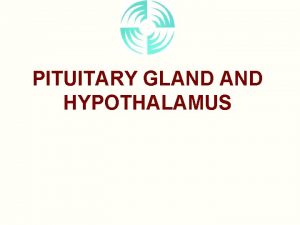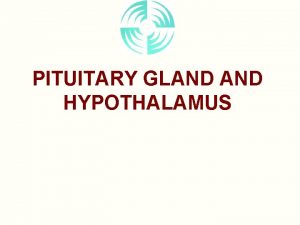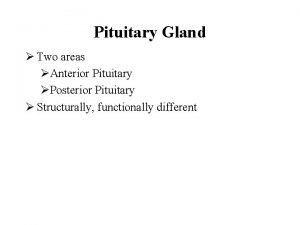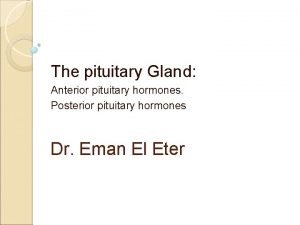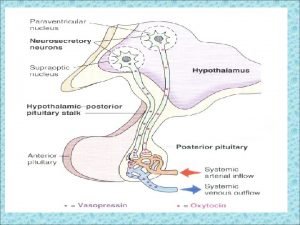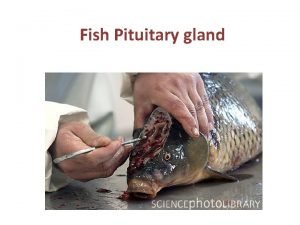Diencephalon Diencephalon Thalamus dorsal thalamus Hypothalamus pituitary gland






































- Slides: 38

Diencephalon

Diencephalon • Thalamus dorsal thalamus • Hypothalamus pituitary gland • Epithalamus habenular nucleus and commissure pineal gland • Subthalamus ventral thalamus subthalamic nucleus (STN) field of Forel

Diencephalon dorsal surface

Diencephalon ventral surface

Diencephalon Medial Surface

THALAMUS

Classification of Thalamic Nuclei I. Lateral Nuclear Group II. Medial Nuclear Group III. Anterior Nuclear Group IV. Posterior Nuclear Group V. Metathalamic Nuclear Group VI. Intralaminar Nuclear Group VII. Thalamic Reticular Nucleus

Classification of Thalamic Nuclei

LATERAL NUCLEAR GROUP Ventral Nuclear Group Ventral Posterior Nucleus (VP) ventral posterolateral nucleus ventral posteromedial nucleus (VPM) ventral posteroinferior nucleus (VPI)

LATERAL NUCLEAR GROUP Ventral Lateral Nucleus (VL) Ventral Anterior Nucleus (VA, L. po. )

LATERAL NUCLEAR GROUP Prefrontal SMA MI, PM SI Ventral Nuclear Group TTT SNr GPi Cbll ML, STT

LATERAL NUCLEAR GROUP Dorsal or Lateral Nuclear Group Lateral Dorsal Nucleus (LD, D. sf. ) Lateral Posterior Nucleus (LP, D. im. & Z. im. ) Pulvinar (P, Pu. )

LATERAL NUCLEAR GROUP cingulate gyrus, precuneus Somesthetic Association Area HF SC, Pretectal Visual Association area

MEDIAL NUCLEAR GROUP Dorsomedial Nucleus (MD) - pars magnocellularis - pars parvocellularis Midline Nuclear Group

ANTERIOR NUCLEAR GROUP anteroventral nucleus (AV, A. pr. ) anterodorsal nucleus (AD, A. d. ) anteromedial nucleus (AM, A. m. ) POSTERIOR NUCLEAR GROUP suprageniculate nucleus (SG, Li. ) nucleus limitans (Lim, Li. ) posterior nucleus (PO, Li. por. )

MEDIAL & ANTERIOR NUCLEAR GROUP MB, HF cingulate gyrus Prefrontal Frontal Cortex Eye Field Basal forebrain Medial Frontal Gyrus SNr, SC, RF

METATHALAMIC NUCLEAR GROUP Medial Geniculate Nucleus (MG) ventral nucleus dorsal nucleus medial nucleus Lateral Geniculate Nucleus (LG) dorsal nucleus ventral nucleus

INTRALAMINAR NUCLEAR GROUP Rostral Intralaminar Nuclei central lateral nucleus, central medial nucleus, paracentral nucleus, Caudal Intralaminar Nuclei (CM-PF nuclear complex) centre median nucleus, parafascicular nucleus,

THALAMIC RETICULAR NUCLEUS Cerebral Cortex Thalamic Reticular Nucleus Thalamocortical Neuron Subcortical Structure

Summary of Thalamic Connectivity I. Sensory Input general sensation special sensation taste, equilibrium, hearing, vision II. Motor Input cerebellum, basal ganglia III. Reticular Formation IV. Limbic System mammillary nucleus hippocampal formation

Sensory Input (1) General Sensation 1. Medial lemniscus VPLc ------ S I, S II 2. Spinothalamic tract VPLc ------ S I, S II POm ------ retroinsular cortex Sm ------- frontal lobe(? ) CL ------- diffuse cortical areas 3. Trigeminothalamic tract VPM ------- S I, S II

Sensory Input (2) Taste sensation VPM pc ------- gustatory area (Brodmann area 43) (3) Sense of equilibrium VPLo ----- S I (4) Auditory sensation MGv ------ A I (Brodmann area 41, 42) MGd ------ A II (5) Vision LGd ----- V I (Brodmann area 17) Pi, Pl ----- V I, V II (Brodmann area 17, 18, 19)

Motor Input (1) Cerebellum VLc, VPLo, - M I (Brodmann area 4), Premotor area (2) Basal ganglia 1. GPi (internal segment of globus pallidus) ---- SMA (supplementary motor area) ------- frontal cortex 2. SNr (pars reticularis of substantia nigra) - fronal cortex ----- medial frontal cortex ----- frontal eye field (Brodmann area 8)

Reticular Formation & Limbic System Reticular formation rostral intralaminar nuclei (CL, Cem, PC), Rh ----- diffuse cortical areas thalamic reticular nucleus (R), LGv ----- adjacent thalamic nucleus Limbic System Mammillary Body AV, AD, AM ----- cingulate gyrus Hippocampal Formation AV, AD, AM ----- cingulate gyrus LD --------- cingulate gyrus, precuneus Re ---------- medial cortex, entorhinal cortex

Clinical Syndromes of the Thalamus Posterolateral thalamic syndromes sensory disorders Thalamic (Dejerine-Roussy) syndrome ----- VP nucleus - pain Medial thalamic syndromes disorders of consciousness thalamic neglect, thalamic amnesia, akinetic mutism Anterolateral thalamic syndromes motor disorders paresis, ataxia, motor incoordination, dysphagia

Thalamic (Dejerine-Roussy) Syndrome Joseph Jules Dejerine (1849 -1917) Gustave Roussy (1874 -1948)

Visual (Optic) Pathway Modality: Vision Receptor: Photoreceptor Cell of Retina Cranial Nerve: II (Optic nerve) 1 st Neuron: Bipolar Cell 2 nd Neuron: Ganglion Cell optic nerve optic chiasm optic tract 3 rd Neuron: Lateral Geniculate Nucleus optic radiation Termination: Visual Areas (V I, V II) Brodmann area 17 (V I), 18, 19 (V II)

RETINA - Pars Nervosa 1. Pigment Epithelium - retinal detachment 2. Neuronal Layer (1) Photosensitive Cell Layer Rod Cell, Cone Cell (2) Bipolar Cell Layer Bipolar Cell Horizontal Cell Amacrine Cell (3) Ganglion Cell Layer Ganglion Cell Optic Nerve (II)

Visual Pathway 1. Optic nerve 2. Optic chiasm 3. Optic tract 4. Lateral geniculate body 5. Optic radiation 6. Visual cortex

Visual (Optic) Pathway

Visual Pathway dorsolateral Lateral Geniculate Nucleus (LGd) Dorsal Nucleus (LGd) Magnocellular Part 1, 2 Parvocellular Part 3, 4, 5, 6 contralateral afferents 1, 4, 6 ipsilateral afferents 2, 3, 5 Ventral Nucleus (LGv) ventromedial part of thalamic reticular nucleus

Optic Radiation (Geniculocalcarine Tract) Meyer’s loop

Clinical Features of Visual Pathway Lesion 1. optic nerve 2. optic chiasm 3. optic tract 4. 5. optic radiation A. unilateral blindness B. bitemporal hemianopsia C. left homonymous hemianopsia D. left inferior homonymous quadranopsia E. left superior homonymous quadranopsia

Signs of Visual Pathway Lesion Optic nerve - ipsilateral blindness Optic chiasm - bitemporal hemianopsia Optic tract - contralateral homonymous hemianopsia Optic radiation - contralateral homonymous quadranopsia - intact light reflex Visual Cortex - contralateral homonymous quadranopsia - macular sparing

Visual Field Defect left inferior optic radiation lesion right superior quadranopsia

Hypothalamus Limbic System

Epithalamus Limbic System Habenular Nucleus Medial Habenular Nucleus Lateral Habenular Nucleus Habenular Commissure Pineal Gland

Subthalamus Basal Ganglia Subthalamic nucleus zona incerta Field of Forel H H 1 ansa lenticularis thalamic fasciculus H 2 lenticular fasciculus
 Hypothalamus and pituitary gland connection
Hypothalamus and pituitary gland connection Hypothalamus and pituitary gland connection
Hypothalamus and pituitary gland connection Endocrine gland hormone
Endocrine gland hormone Thyoid gland
Thyoid gland Pituitary gland and pineal gland spiritual
Pituitary gland and pineal gland spiritual Vplnt
Vplnt Papez circuit ppt
Papez circuit ppt Epithalamus
Epithalamus Diencephalon boundaries
Diencephalon boundaries Blood supply of pituitary gland
Blood supply of pituitary gland Division of pituitary gland
Division of pituitary gland Colloid anatomy
Colloid anatomy Structure of posterior pituitary gland
Structure of posterior pituitary gland Hypophyseal fossa and pituitary gland
Hypophyseal fossa and pituitary gland Anterior pituitary
Anterior pituitary Third gender full body parts pictures
Third gender full body parts pictures Prolactin hormones
Prolactin hormones Nerve supply of pituitary gland
Nerve supply of pituitary gland What is the name
What is the name Pituitary gland
Pituitary gland Morphology of pituitary gland
Morphology of pituitary gland The embryonic origin of the anterior pituitary gland is
The embryonic origin of the anterior pituitary gland is Endocrine histology
Endocrine histology N
N Pituitary gland hormones
Pituitary gland hormones Hypophyseal fossa and pituitary gland
Hypophyseal fossa and pituitary gland Putery gland
Putery gland Posterior pituitary blood supply
Posterior pituitary blood supply Cavernous sinus
Cavernous sinus Dictalie
Dictalie Pituitary gland disorders
Pituitary gland disorders Pituitary gland
Pituitary gland Endocrine weight loss
Endocrine weight loss Diaphragm sella
Diaphragm sella Hashitoxicosis
Hashitoxicosis Spinal cord structures
Spinal cord structures Fertilization occurs
Fertilization occurs Neurotransmitter of somatic nervous system
Neurotransmitter of somatic nervous system Tropic hormones hypothalamus
Tropic hormones hypothalamus
